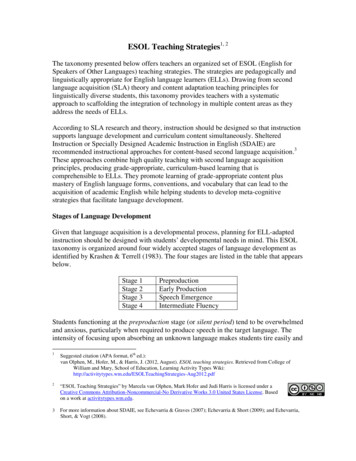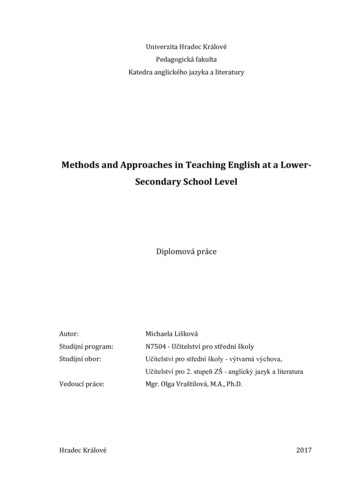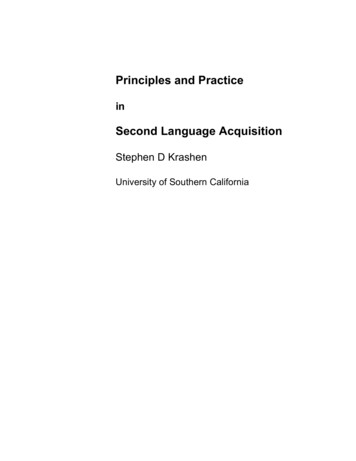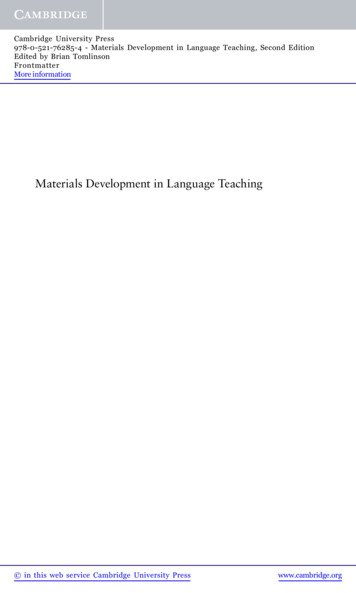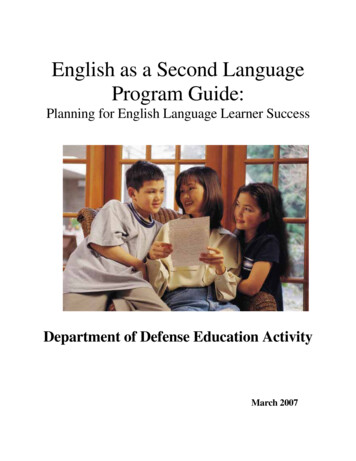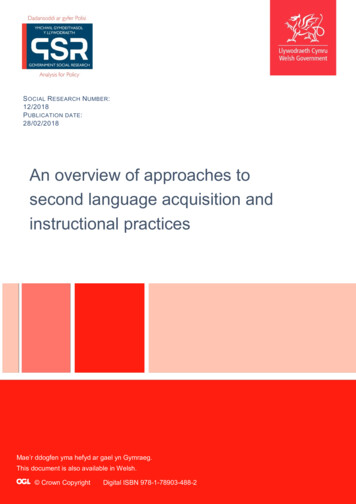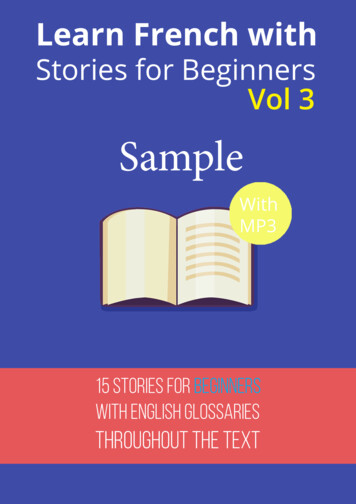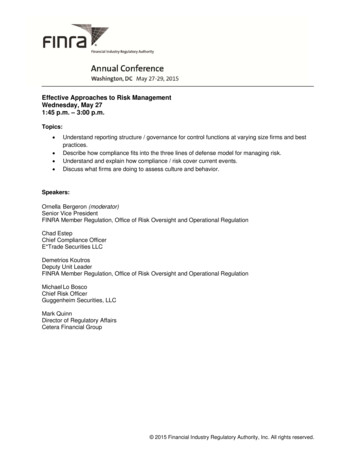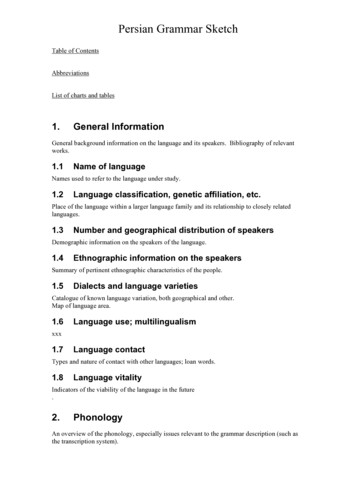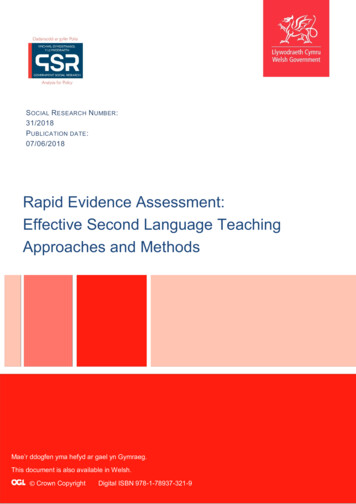
Transcription
S OCIAL R ESEARCH N UMBER :31/2018P UBLICATION DATE :07/06/2018Rapid Evidence Assessment:Effective Second Language TeachingApproaches and MethodsMae’r ddogfen yma hefyd ar gael yn Gymraeg.This document is also available in Welsh. Crown CopyrightDigital ISBN 978-1-78937-321-9
Rapid Evidence Assessment: Effective Second Language TeachingApproaches and MethodsAuthors: Fitzpatrick, T., Morris, S., Clark, T., Mitchell, R., Needs, J.,Tanguay, E. and Tovey, B.Full Research Report: Fitzpatrick, T., Morris, S., Clark, T., Mitchell, R., Needs, J., Tanguay,E. and Tovey, B. (2018). Rapid Evidence Assessment: Effective Second LanguageTeaching Approaches and Methods. Cardiff: Welsh Government, GSR report number31/2018.Available at: thods/?lang enViews expressed in this report are those of the researcher and not necessarily those of theWelsh Government.For further information please contact:Catrin RedknapSocial Research and Information DivisionKnowledge and Analytical ServicesWelsh GovernmentCathays ParkCardiffCF10 3NQTel: 0300 025 5720Email: catrin.redknap@gov.wales
Table of contentsList of Tables. 4List of Figures . 4Glossary. 51.Introduction . 7Aims and rationale for the Rapid Evidence Assessment (REA) . 7Policy background and development . 8Project objectives . 9Investigative framework – definition and interpretation of terms . 9Project Team . 11Approach and structure of the report . 112.Methodology. 13Defining the research question . 13Methodological approach . 14Phase 1 – Search . 16Database searches . 16Supplementary searches . 18Quality assurance at Phase 1 . 20Phase 2 – Screening, selection and categorisation . 20Phase 2a – Screening . 20Phase 2b – Identification of thematic domains, and preliminary categorisation . 21Quality assurance at Phase 2 . 23Phase 3 – Detailed data extraction and weighing of evidence . 23Quality assurance at Phase 3 . 26Phase 4 – Clustering items and synthesising key findings . 263.Findings. 27Vocabulary competence . 29The effect of CLIL instruction on vocabulary development . 29Focusing attention and intentional learning activity on form and meaning of individualvocabulary items . 311
Input-Only, and Input plus Interaction Instruction. 32Involvement Load . 33Integrating imagery, gesture and movement. 34Summary of Vocabulary Competence findings . 35Grammatical competence . 35Explicit Instruction . 35Content and Language Integrated Learning (CLIL) . 37Oracy and Literacy . 37Summary of Grammatical Competence findings . 38Reading competence . 38Developing lower-level processing skills . 39Developing higher-level processing skills . 41Summary of Reading Competence findings. 43Writing competence . 43The role of technology in writing development . 43Non-traditional approaches to writing instruction . 45Taught strategies to promote writing skills . 47Summary of Writing Competence findings . 48Speaking and listening competence . 48Interaction and negotiating meaning . 49Pronunciation . 51Listening . 52Speaking and listening strategies . 53Summary of Speaking and Listening Competence findings . 54General language competence . 54CLIL and partial CLIL . 55Amount and distribution of instruction time . 57Isolated and integrated Form Focused Instruction . 57Technology and language learning . 58Use of songs in the language classroom . 59A note on approaches and methods . 59Summary of General Language Competence findings . 602
Summary of findings applied to the Welsh context . 604.Notes on excluded literature and future research imperatives . 62Bilingualism and the “cognitive advantage” . 62Identity and language learning motivation . 63Cross linguistic relations, translanguaging and biliteracy . 64Effectiveness of immersion education . 645.Concluding remarks . 66References . 68Annex A: Project team members, roles and affiliations . 83Annex B: Data Extraction Form (adapted from EPPI-Centre 2007) . 84Annex C: Items that met the Phase 2 inclusion criteria . 943
List of TablesTable 2.1: Methods for addressing key REA considerations . 15Table 2.2: Relevance criteria used at Phase 2a - Screening . 20Table 2.3: Final section of Data Extraction Form (adapted from EPPI-Centre 2007) . 25Table 2.4: Calculation of overall weight of evidence (I.4 in Table 2.3 above) . 25Table 3.1: Summary of items (vocabulary competence) . 29Table 3.2: Studies of CLIL and vocabulary learning. 30Table 3.3: Summary of items (grammatical competence) . 35Table 3.4: Summary of items (reading competence) . 38Table 3.5: Summary of items (writing competence) . 43Table 3.6: Summary of items (speaking and listening competence) . 48Table 3.7: Summary of items (general language competence) . 54Table A.1: Project team members, roles and affiliations . 83Table B.1: Data Extraction Form (adapted from EPPI-Centre 2007) . 84Table C.1: Items that met the Phase 2 inclusion criteria . 94List of FiguresFigure 3.1: Flowchart of items included at each methodological stage . 27Figure 3.2: Distribution by competence of items included in the synthesis of evidence . 294
GlossaryAoLEArea of Learning and ExperienceASRAutomatic Speech RecognitionBESBest Evidence SynthesisCALLComputer Assisted Language LearningCBIContent Based InstructionCEFRCommon European Framework of Reference for LanguagesCLILContent and Language Integrated LearningCLTCommunicative Language TeachingDDLData Driven LearningDELTADiploma for Teaching English to Speakers of Other LanguagesDGBLDigital Game Based LearningEFLEnglish as a Foreign LanguageEIElicited ImitationELLEarly Language LearningEPPIEvidence for Policy and Practice InformationERICEducational Resources Information CentreESSEnglish as a School SubjectFFIForm Focused InstructionFonFFocus on Form (attention to a vocabulary item during a communicativeactivity)FonFsFocus on Forms - learning focus is the vocabulary itemsGJTGrammaticality Judgement TestGSRGovernment Social ResearchGTMGrammar Translation MethodICTInformation and Communication TechnologyIELTSInternational English Language Testing SystemILDIndividual Learner Difference5
KSKey StageL1First languageL2Second languageLEALocal Education AuthorityLLBALinguistics and Language Behaviour AbstractsNLWNational Library of WalesNNSNon-native speakerPICOPopulation, Intervention, Comparison, OutcomesPPPPresentation, Practice and ProductionREARapid Evidence AssessmentSIStrategy InstructionSRSDSelf-Regulated Strategy DevelopmentTBLTask-Based LearningWGWelsh Government6
1.Introduction1.1The purpose of the Rapid Evidence Assessment (REA) reported in this document isto inform the Welsh Government’s planning and delivery of Welsh languageprovision for learners aged 3-16 years, as it undertakes reform of curriculum andassessment arrangements in Wales. The REA was commissioned in the light of twosignificant national policy drivers: the development of a new school curriculum forWales, initiated by the Successful Futures report (Donaldson, 2015), and Cymraeg2050: a million Welsh speakers (Welsh Government, 2017). Together, thesenecessitate a significant review of language education in Wales, and createpotential for a paradigm shift in approaches to language teaching and learning. Thiscontext provides a rare opportunity, from a research perspective, to focus on theeffectiveness of language education, in conditions that will tolerate, evenencourage, a transformational change to teaching approaches and methods. TheREA reported here, comprising an assessment of high quality, relevant researchyielded by a principled and extensive literature search, represents a state-of-the-artresearch platform for policy development. While its relevance to Wales is explicit,this constitutes a significant contribution to teaching policy and practice in all nondominant target language contexts.Aims and rationale for the Rapid Evidence Assessment (REA)1.2In 2017 Welsh Government (WG) identified a key area in which a rapid evidenceassessment (REA - ‘the project’) should be undertaken: the effectiveness ofapproaches and methods in second language teaching. The aim of the project wastherefore to assess research on language teaching practices and interventions usedin international and national contexts parallel or comparable to Wales, in order toinform WG planning for delivery of Welsh language provision for learners aged 316. The project will contribute to WG’s awareness and appreciation ofapproaches/methods that are likely to give learners effective functional skills in theWelsh language by the age of 16. The specific research question addressed in thisreport is:What teaching approaches and methods are effective in developing young learners’second language competence, according to high quality empirical evidence?7
Policy background and development1.3There are three principal WG policies which provide the context of the project: Cymraeg 2050 – A million Welsh speakers.1 One of the sea-changes required toenable WG to achieve its goal is to transform how learners are taught Welsh,with the aim that by 2050 at least 70 per cent report that they can speak Welshby the time they leave school. This will require an increase in the number ofprimary and secondary teachers who can teach Welsh as a subject. In secondaryschools this will be from 500 in 2017 to 900 by 2031 and to 1,200 by 2050.Improving how Welsh is taught in English-medium schools is noted as a priority. A Curriculum for Wales – A Curriculum for Life.2 Six Areas of Learning andExperience (AoLEs) are identified in the new curriculum for Wales, withprogression within each AoLE based on continua of learning. The Welshlanguage (a compulsory element of the curriculum up to age 16 for all learners)falls within the AoLE for Languages, Literacy and Communication. The emphasison learning Welsh is defined as developing the language as a means ofcommunication with progress towards “transactional competence” (Donaldson,2015 p. 60) by age 16. Education in Wales: Our National Mission.3 The development of atransformational approach to the learning, teaching and assessment of Welsh isa stated aim of this action plan covering the period up until 2021. The aim is toensure that all learners will be able to use Welsh when they leave school. One ofthe priorities for professional learning here is to teach Welsh as a living languageand to ensure that greater numbers are able to work effectively in Welsh-mediumand/or bilingual settings. The vision to enable all learners to develop their Welshlanguage skills and use Welsh confidently in everyday life is reiterated in Welshin Education: Action Plan 2017-2021.4 Particularly relevant to this REA and toenabling WG to realise its vision for children and young people are thedevelopment of a new curriculum to inspire learners to learn and use thelanguage, and the need to enhance motivation through accurate measurement ofprogress, together with ensuring that teaching and learning are based onteachers’ understanding of the most effective language acquisition -21-en.pdf28
Project objectives1.4The aim of this REA is to identify, assess the quality of, scrutinise and reportresearch relating to effective second language teaching approaches and methodsfor use with 3-16 year olds, taking a principled, systematic and transparentapproach to literature search, screening and synthesis. The main objectives of theproject are: Objective A – to conduct a search and scrutiny of published research within theparameters described below (Section 2. Methodology of this report); Objective B – based on what is found through Objective A, to produce a state ofthe art synthesis of the most relevant and highest quality research, organisedthematically (Section 3. Findings); Objective C – to assess how the research findings map onto Welsh languagepedagogy (3-16 year olds), particularly in the context of Education in Wales: ournational mission (Welsh Government 2017) (Summary of findings applied tothe Welsh context); Objective D – to indicate related research areas which, while outside the scopeof this report, will be key to achieving the policy aims outlined in 1.2 and 1.3above (Section 4. Notes on excluded literature and future researchimperatives).1.5The project parameters require that research will only be regarded as relevant andsuitable for inclusion when it: is directly or indirectly relevant to language learners aged 3-16 years old; is directly or indirectly relevant to the context of teaching Welsh in Wales (forexample, it has relevance to the teaching of non-dominant target languages); focuses on “approach” and/or “method”; research on theoretical models, orteaching techniques/activities are only included if they are relevant to anapproach or method; addresses deliberate, within class, teaching of second languages that arehuman, written/spoken, languages.Investigative framework – definition and interpretation of terms1.6The framework for the investigation was based on parameters using PICO(Richardson, Wilson, Nishikawa, & Hayward, 1995). While originally designed forclinical contexts, the Population Intervention Comparison Outcomes9
framework, and the overarching principle of evidence-based practice, makes ithighly appropriate for the definition of terms in our current investigative framework: Population: learners of Welsh as a second language aged 3-16. ‘Languagelearner’ indicates a deliberate intention on the part of the learner and/or teacher(thereby excluding immersion contexts). ‘Language’ here is human,written/spoken language (therefore not including Sign Languages or computerlanguages, for example). ‘Welsh second language’ is used with the specificmeaning applied to learners who are following a curriculum solely orpredominantly delivered through the medium of English. This differentiates themfrom second language speakers of Welsh who acquire the language through apredominantly Welsh-medium curriculum and/or within an immersion setting.Welsh L2 does not, therefore, necessarily reflect learners’ linguistic backgroundand exposure to Welsh prior to education, nor does it include those learners forwhom Welsh may be a second (or other) language who are in Welsh-medium orimmersion provision. Intervention / Exposure: classroom-based or -related teaching approaches andmethods. Theories of language learning were beyond the remit of the study, aswere interventions beyond the reach of the classroom. ‘Approach’ and ‘method’are terms whose definition has changed over time and is contested (Hall, 2011).In this project, ‘approach’ is taken as a set of values, principles, and beliefs aboutfactors that drive learning, and ‘method’ is taken as the systematic engagementof learners with language (definitions informed by e.g. Hall, 2011; Chapter 22 ofRichards & Rodgers, 2014). Techniques and activities were included, only wherethey exemplified methods and approaches. Comparisons: Where the literature permits, comparisons betweenmethods/approaches were made on the basis of ‘effectiveness’. Theinterpretation of ‘effectiveness’ which informs this investigation is the deploymentof a teaching method or approach in a classroom that enhances learnerperformance, in a measurable and sustained way, in one or more of thecompetences identified in the methodology. Outcome: language competence, particularly (given the emphasis in SuccessfulFutures) with reference to ‘transactional competence’, and interpretations of thecomponents of this.10
Project Team1.7The REA took place between November 2017 and March 2018. The core projectteam of two senior researchers and four research assistants was based at SwanseaUniversity. An advisory team fed into the methodological process at critical stages,and most influentially in developing the investigative framework and contributing tothe supplementary searches (see Section 2. Methodology). The team wasconstituted in order to maximise the reach of expertise in areas relevant to theproject objectives and methodology. Half the team members have previousexperience as classroom language teachers (of Welsh, Irish, English, French,Catalan and Spanish), and team members’ research and scholarly activity coversareas including: Second language acquisition; Language education policy;Language pedagogy; Content and Language Integrated Learning (CLIL); ComputerAssisted Language Learning (CALL); Motivation studies; Language assessment;Teacher education; Inter-relationship between child second language/foreignlanguage learning, vocabulary and literacy development; The effects of age insecond language learning; Formulaic language acquisition; Language learning inminority language contexts; Language acquisition and bilingualism amongstchildren and adults. A full list of the project team members is in Annex A: Projectteam members, roles and affiliations.Approach and structure of the report1.8The potential scope of the report is vast, given the quantity of research literaturepublished in the field of language learning and teaching. As an illustration of this, asearch on the Scopus Database titles, keywords and abstracts for “[approaches ORmethods] [language] [learning OR teaching]” returns over 43,000 items. Inorder, then, to adhere to the principled, selective approach demanded by an REA,to target the literature most acutely relevant to the REA, and to meet the ‘rapidity’criteria of the REA, a sophisticated search mechanism was required (Objective A inProject objectives above). Section 2. Methodology of the report sets out themethod we devised for this, and the quality assurance measures and contingencieswe put in place. Findings then had to be synthesised and presented in a way thatwas fit for purpose (Objectives B and C above), and here the challenge wasthreefold:11
i)A framework driven by conventional taxonomies of method and approach,established a priori, would risk excluding research on a) methods that donot sit obviously under the traditional (often unhelpfully broad) banners of‘task-based learning’, ‘grammar translation’, and so on, and b) practiceemerging from the “principled eclecticism” and “principled pragmatism”(see e.g. Kumaravadivelu 1994) of the post-method era.ii)Effective language teaching and learning is by no means solely generatedby planned, teacher-controlled, classroom-based endeavours; a vast arrayof additional influences and variables play critical roles in languagelearning, and these must be acknowledged.iii)“Transactional competence” (Donaldson, 2015) is presented as a measureof effectiveness in the policy context, but the term itself is under-defined(generating only one ‘hit’ in Scopus, for example), and its componentsmust be identified.1.9Section 2. Methodology of the report sets out the methodology used to addressthese challenges, and presents the rationale for organising the project findings(Section 3. Findings) according to a thematic approach based on languagecompetences. Finally, in connection with point (ii) in the paragraph above andObjective D in Project objectives, Section 4. Notes on excluded literature andfuture research imperatives of the report focuses on areas of research which,though excluded from the main business of this project, are critical considerations inthe formation of policy for Welsh language education in Wales.12
2.MethodologyDefining the research question2.1The aim of the project was to provide a balanced assessment of research literatureevidence in order to help inform the Welsh Government’s planning and delivery ofWelsh language provision for learners aged 3-16. In order to do this in such a wayas to maximise both fitness-for-purpose and feasibility, precise framing of aresearch question and establishment of research parameters was essential. Thesocial and psychological complexity of language learning means the breadth andquantity of research literature with relevance to the topic is vast. This was evident inthe fact that initial scoping of policy frameworks (see Policy background anddevelopment) and consultation within the project team, generated a preliminary setof twelve broad areas of relevance to the WG’s policy ambition. These were:i)Effectiveness of approaches/methods when applied to the young languagelearner context;ii)Immersion and CLIL (Content and language Integrated Learning);iii)Assessment of learning;iv) Quality and intensity of learners’ exposure to language;v)Age and cognitive development;vi) Practitioner skills and training;vii) The processes by which ‘transactional competence’ develops;viii) Development of bi- and multi-literacy;ix) Cognitive and social advantages of language learning and bilingualism;x)Motivation and attitude;xi) Role of technology in language learning;xii) Individual learner differences.2.2That these areas are of core relevance to the policy ambition context of the project,and relate directly to considerations of teaching methods and approaches isundeniable. However, trial database searches encompassing all these themesyielded hundreds of thousands of results, indicating that this approach would riskgenerating wide-ranging and unfocused findings, and was in any case not feasiblewithin the parameters of a REA. It was therefore decided to constrain the scope ofthe research question to a tight interpretation of approach and method (see Phase2a – Screening), while acknowledging that consideration of iii-xii above would also13
be essential to informing policy development (see Section 4. Notes on excludedliterature and future research imperatives).2.3This decision narrowed our focus to i) effectiveness of approaches/methods whenapplied to the young language learner context; and ii) immersion and CLIL (Contentand language Integrated Learning). On closer scrutiny of ii), it was decided thatwhile CLIL’s explicit attention to language development (as well as academiccontent) render it relevant to this REA, the theoretical foundation of ‘Immersion’(that exposure without explicit language-focused instruction will lead to acquisition)is not compatible with the “deliberate, within class, teaching of second languages”parameter established in Project objectives above, and is therefore not within thescope of the REA.2.4The question addressed by this review is, then: What teaching approaches andmethods are effective in developing young learners’ second language competence,according to high quality empirical evidence?Methodological approach2.5To answer this research question, a rigorous approach to literature search,screening, scrutiny and synthesis was required. The expertise and experience ofthe project team supplemented this, enabling the authors to tap into state-of-the-artknowledge across areas relevant to our project focus, and to make contingency forcrucial literature not captured by the database search (for example because articletitles do not transparently reflect content, or items fall outside search engine capturezones, or are incompatible with our search terms).2.6The following sub-sections outline the objective investigative framework devised forthe project. This was based on the parameters outlined in Project objectives of theintroduction, and was informed by the REA considerations in Table 2.1, the GSR(Government Social Research) Rapid Evidence Assessment toolkit and EPPI(Evidence for Policy and Practice Information) Centre guidance.5 The investigationproceeded
approaches and methods in second language teaching. The aim of the project was therefore to assess research on language teaching practices and interventions used in international and national contexts parallel or comparable to Wales, in order to inform WG planning for delivery of Welsh

